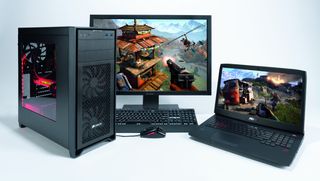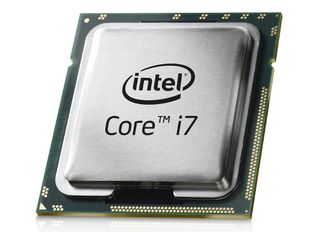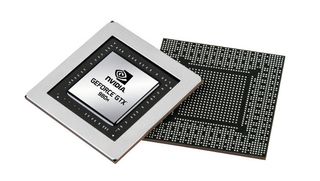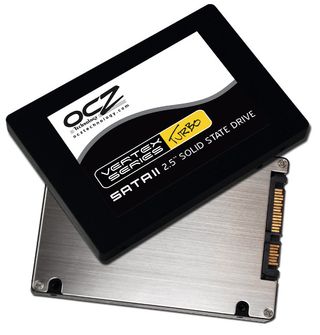Laptop vs. Desktop

This article was published in the February 2015 issue of Maximum PC. For more trusted reviews and feature stories, subscribe here.
Gaming laptops have come a long way, but can they really replace desktop rigs?
For a long time, many PC gamers scoffed at the idea of gaming laptops. After all, how could you fit all that power in such a small form factor?
And even if you could somehow squeeze it in, it’s got to be deafeningly loud or incredibly heavy, right? Well, the gaming notebook sector is advancing, and it’s doing so by leaps and bounds. So much so that big gray box companies are taking notice. HP, for instance, is jumping back in with its Omen gaming notebook.
Gone are the days when a modestly powerful gaming laptop had to be a back-breaker. Many aren’t much thicker than some of the sleek Ultrabooks out there now. But what of performance? The gap between desktop and mobile GPU performance is narrowing faster than a teen’s teeth with braces.
So can a desktop-replacement laptop now truly live up to its name? There’s only one way to find out, and that’s by throwing them both into the Thunderdome. Let battle commence!
Slugging It Out
Who’s your money on? The heavyweight champ or the light-footed contender? Desktops and gaming laptops go eight rounds to see which is best
GPU
Let’s face facts. As powerful as gaming laptop GPUs have become, they will always be slower than their desktop counterparts. You can always cram more power into larger components; it’s simple physics. But gaming laptop GPUs are narrowing the divide, and this has been the case with every passing generation of mobile GPUs. According to Nvidia, its Fermi-based 480M GPU only offered 40 percent of the performance of its 480 desktop equivalent back in 2010. Nvidia claims the gap narrowed to 60 percent with the Kepler-based 680M. Now Nvidia says the 980M is roughly 70–80 percent as fast as its current flagship GTX 980. From our internal testing, our numbers don’t support those figures across the board, but they aren’t terribly far off.
PC Gamer Newsletter
Sign up to get the best content of the week, and great gaming deals, as picked by the editors.
But performance issues aside, a glancing blow to mobile GPUs is that you can’t typically swap them out. The beauty of gaming on a desktop PC is that if a beefer card comes along, you can just pop it in. In addition, while there are some dual-GPU options in the gaming notebook space, they are few and far between. And four-way mobile GPU options? Fuggedaboutit.
Winner: Desktop

The performance gap between mobile and desktop GPUs is shrinking.
CPU
Just about all the high-end gaming laptops that arrive in our Lab come with quad-core i7 CPUs, but in all honesty, they hold a rinky-dink candle to their desktop counterparts. Comparing high-end mobile quadcore to high-end desktop quad-core, we’re talking a delta of 40–50 percent. And that’s not to mention the six- and eight-core CPUs desktops can offer.
Sure, some crazy beast laptops such as AVADirect’s Clevo P570WM squeeze hexa-core desktop CPUs into their monstrous chassis, but notebooks like that are rare. Plus, you can’t watercool them, meaning you can’t unleash the beast to its full potential. To avoid overheating, laptop CPUs typically throttle themselves, and if they don’t, they tend to sound like shop vacs. Not great.
But arguably the biggest win for the desktop column here is the modularity factor. You just can’t beat swappable CPUs.
Winner: Desktop

Mobile CPUs are still lagging behind their desktop counterparts.
Sound
Years ago, laptop speakers were weak pieces of crap. But these days, while they may not please the harshest audiophiles, most high-end gaming laptops now offer plenty of volume firepower. Hell, some even offer a 2.1 setup with a bass speaker underneath the chassis. And you don’t have to spend a fortune to get good audio from a gaming notebook. Lenovo’s Y500 gaming series, which retail around $1,000, offer great sounding speakers licensed by JBL.
This should be an easy win for gaming laptops, right? Unfortunately, sound goes both ways, and fan noise is a major factor. A good laptop like the Asus ROG G751 will run near silent under load, but something that’s too powerful for its britches, such as the AVADirect Clevo W230ST, can sound annoyingly loud.
Your mileage may vary here, but with both ends of this spectrum to consider, we’re calling it a draw.
Winner: Tie
RAM
Laptops aren’t known to be modular, but most of them allow you to swap out RAM. In fact, some will even let you plop in up to 32GB, which is more than enough for gaming and everyday tasks. In terms of pricing, both are pretty competitive, with the cost equalling roughly $10 per gig of DDR3 on either platform.
If we had to give one platform the nod, it would have to go to the desktop. Some gaming laptops, most notably the really thin ones, make it difficult to access the RAM slots. Typically, the only way to do this is to completely unscrew the notebook’s base, which usually voids the warranty.
Winner: Desktop
Storage
For a long time, smaller 2.5-inch laptop drives have generally been smaller and/or pricier than traditional 3.5-inch HDDs. With SSDs coming down in price and increasing in storage capacity, however, laptops can now offer a decent amount of storage at a reasonable cost. And with m.sata SSDs being so tiny, you don’t have to sacrifice thinness for storage space. Still, it’s almost comical to even compare the advantages of a desktop when it comes to storage, where your biggest limiting factor is how many SATA ports you have. This means you aren’t constrained to using just 2.5-inch laptop drives. Knowing you can expand your storage by 4TB simply by plugging in one SATA cable... that’s a good feeling.
Winner: Desktop

The rise of the SSD has meant big improvements for laptop storage.
Keyboard
We all love our mechanical keyboards, which have been a mainstay of gaming desktops for years, so you’re probably thinking this is an easy win for the desktop column, right? But while most gaming laptop keyboards merely get the job done, they are also “free.” In addition, you could always hook up a mechanical keyboard to your gaming laptop if you need to get your clickity-clackity fix. While you may scoff this off as awkward, it’s actually fairly common at big national LAN events.
Furthermore, some gaming laptops like MSI’s GT80 will be shipping with integrated mechanical keyboards, though the jury is still out on how well they’ll work.
Winner: Laptop
Monitor
There’s a lot of quality variance when it comes to laptop monitors. We’re beginning to see a lot of UHD panels out there, and then there’s also the IPS versus TN facet to consider. Most gaming laptop monitors come in the 60Hz variety, unless they support stereoscopic 3D, but those have been rare birds since stereoscopic 3D glasses failed to take off.
But even if you’ve got a crummy 1080p TN display, you could always plug a nice discrete monitor into the laptop. Like the keyboard category, free is better than not free, and you still get the discrete monitor.
The one big downside is that laptop displays are smaller, and you can’t raise their screens with a stand. Those quibbles aside, though, free monitor beats not-free monitor.
Winner: Laptop
Portability
Desktops may have the power and the modularity, but it’s tough to beat the portability that a laptop offers. Even if you could get a powerful PC in a relatively small mini-ITX form factor, they’re still bigger and heavier than the fattest gaming laptops out there. Plus, you’ve got to lug around a monitor, keyboards, and cables galore. For situations like LAN parties, ain’t nobody got time for that.
Winner: Laptop
Conlusion
With the freedom to easily swap out components, coupled with the power they offer, it’s clear the desktop PC isn’t going anywhere. Having said that, however, as good as the desktop platform is, you shouldn’t dismiss gaming laptops too swiftly. They’ve come a long way and are getting more powerful with each passing The rise of the SSD has meant big improvements for laptop storage. swiftly year. Believe it or not, the performance gap is narrowing (though it’s unlikely to ever catch up completely). Furthermore, a lot of the other issues that have plagued gaming laptops, like size, weight, and noise, are slowly being ironed out.
In short, we think you should allow plenty of room at the table for both a desktop and a gaming laptop.
Most Popular


